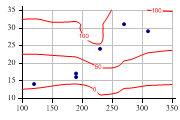| Professional charting tools for .Net developers |
Introducing SharpPlot
Your First Chart
Recent Updates
Sample Charts
Tutorials
General Tutorials
Chart Tutorials
SharpPlot Class
Properties
Structures
Enumerations
Style examples
Glossaries
Active Charts
VectorMath Class
DBUtil Class
Get SharpPlot
Download SharpPlot
Buying SharpPlot
SharpPlot Support
Upgrading from GraPL
Release notes
Reference > Methods > DrawContourPlot Method
SharpPlot.DrawContourPlot Method
Generate contour plot from xyz values passed as 3 arrays.
Example
sp.SetMargins(6,18,18,4); sp.SetMarkers(Marker.Bullet); sp.ContourPlotStyle = ContourPlotStyles.GridLines|ContourPlotStyles.Curves; sp.SetXTickMarks(50); sp.SetZTickMarks(50); sp.MeshDensity = 5; ydata = new int[] {190,270,310,120,190,230}; xdata = new int[] {17,31,29,14,16,24}; elevation = new int[] {12,65,77,7,9,112}; sp.DrawContourPlot(ydata,xdata,elevation);
The short tutorial develops several examples, showing various strategies for contour fitting.
Overloads
- public void DrawContourPlot(int[] xValues,int[] yValues,int[] zValues);
- public void DrawContourPlot(double[] xValues,double[] yValues,double[] zValues);
Description
Contour plots are often an excellent alternative to 3D presentations where the object is to model three-dimensional data. Obviously, they can be used ‘just like a map’ where you may have a set of spot-heights (z-values) at various locations on the xy-plane. In this case, there is no particular shape assumed for the landscape, and the contours would simply be drawn to give the best ‘smooth interpretation’ of the recorded heights.
Another good use of contour plots is to fit some kind of model to the results from any experiment where two factors are systematically altered, and a third one is measured. In this case, the contours represent the model (they will simply be angled lines if the model is linear in both x and y directions) and make it very easy to read off the predicted result for any combination of input variables.
Several examples of various types of fitted contours are given in the tutorial. You will almost certainly need to experiment with the Order of fit and Flexibility properties to get the best results for your particular data.
See also ...
Understanding | SharpPlot | Flexibility | ScatterPlotStyle | SetOrderOfFit
